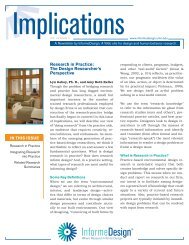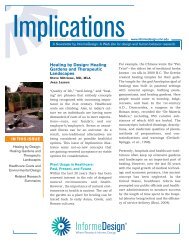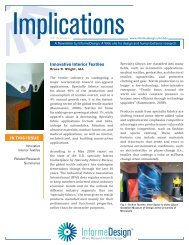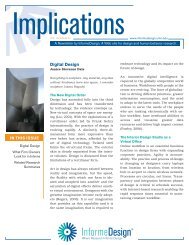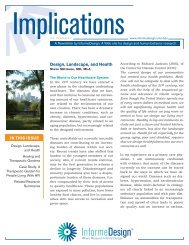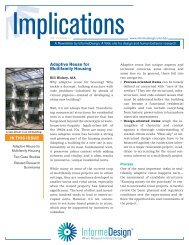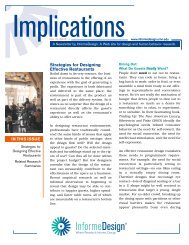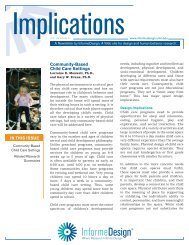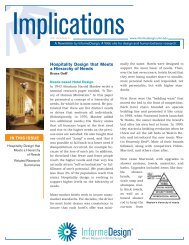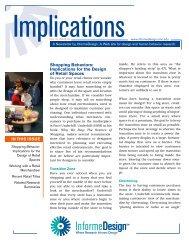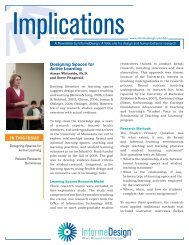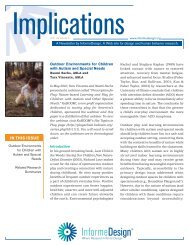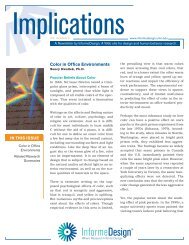Aging in Place: Breaking the Barriers - InformeDesign
Aging in Place: Breaking the Barriers - InformeDesign
Aging in Place: Breaking the Barriers - InformeDesign
You also want an ePaper? Increase the reach of your titles
YUMPU automatically turns print PDFs into web optimized ePapers that Google loves.
Implications<br />
www.<strong>in</strong>formedesign.umn.edu<br />
2<br />
issues of ag<strong>in</strong>g to <strong>the</strong> design community, medical<br />
research is <strong>in</strong>vestigated, and simplified to impactful<br />
elements, while ma<strong>in</strong>ta<strong>in</strong><strong>in</strong>g its <strong>in</strong>tegrity. The goal<br />
is to understand how ag<strong>in</strong>g impacts <strong>the</strong> daily life<br />
and activities of <strong>the</strong> elderly, and to design spaces<br />
accord<strong>in</strong>gly.<br />
In consultation with Julie Masters, University of<br />
Nebraska, Omaha Gerontology Department, research<br />
reveals n<strong>in</strong>e specific, age-related ailments that affect<br />
<strong>the</strong> built environment <strong>in</strong> various ways for those who<br />
would prefer to “age <strong>in</strong> place.” These ailments are<br />
most commonly associated with ag<strong>in</strong>g. Sometimes<br />
<strong>the</strong>y occur s<strong>in</strong>gly and sometimes <strong>the</strong>y occur <strong>in</strong><br />
comb<strong>in</strong>ation. It is <strong>the</strong>refore important to understand<br />
not only <strong>the</strong> characteristics of each, but <strong>the</strong>ir impact<br />
on ag<strong>in</strong>g <strong>in</strong>dividuals <strong>in</strong> <strong>the</strong> built environment. The<br />
most common ailments consist of:<br />
Arthritis<br />
Muscular Loss<br />
Cardiovascular Diseases<br />
Neurological Diseases<br />
Diabetes<br />
Osteoporosis<br />
Hear<strong>in</strong>g Impairment<br />
Vision Impairment<br />
Mental Disorders<br />
Prevalent Occurrences<br />
The range of ailments and disorders is broad, and<br />
variable <strong>in</strong> terms of effects. Here are a few of <strong>the</strong> most<br />
common ones afflict<strong>in</strong>g our ag<strong>in</strong>g population. The<br />
statistics are sober<strong>in</strong>g. Most people age 75+ have at<br />
least one jo<strong>in</strong>t affected by arthritis. From 2003-2005,<br />
50% of adults 65 years or older reported an arthritis<br />
diagnosis (MMWR, 2006). Women are impacted 2-3<br />
times more than men by rheumatoid arthritis. Most<br />
hear<strong>in</strong>g loss beg<strong>in</strong>s between 40-50 years of age. Over<br />
28% of <strong>in</strong>dividuals age 65 and older have a measurable<br />
hear<strong>in</strong>g impairment. By age 85, 50% of <strong>in</strong>dividuals<br />
have a hear<strong>in</strong>g impairment. Static acuity (sharpness<br />
of a stationary visual image) decl<strong>in</strong>es about age 40;<br />
and by <strong>the</strong> 70s, it has decreased by 30% compared<br />
to people <strong>in</strong> <strong>the</strong>ir 20s. Depth perception beg<strong>in</strong>s to<br />
decl<strong>in</strong>e dur<strong>in</strong>g <strong>the</strong> 50s and a 60-year-old person may<br />
require 2 to 3 times as much light to see as a 20-yearold;<br />
with <strong>the</strong> amount of light required doubl<strong>in</strong>g for<br />
each 13 years after <strong>the</strong> age of 20 (Centers for Disease<br />
Control and Prevention, 2009). One <strong>in</strong> two women<br />
and one <strong>in</strong> eight men over 50 years of age will have an<br />
osteoporosis-related fracture (National Osteoporosis<br />
Foundation, 2009). The physical limitations of ag<strong>in</strong>g<br />
do cause problems <strong>in</strong> some general areas, potentially<br />
affect<strong>in</strong>g people’s ability to live effectively on <strong>the</strong>ir own.<br />
These general limitations are briefly itemized below.<br />
Physical Limitations<br />
In general, ag<strong>in</strong>g-related ailments may cause some<br />
degree of problem <strong>in</strong> <strong>the</strong> follow<strong>in</strong>g areas:<br />
• gripp<strong>in</strong>g, p<strong>in</strong>ch<strong>in</strong>g, twist<strong>in</strong>g and squeez<strong>in</strong>g<br />
(hands)<br />
• bend<strong>in</strong>g or reach<strong>in</strong>g for objects<br />
• lift<strong>in</strong>g objects above shoulders or from below<br />
knees<br />
• gett<strong>in</strong>g <strong>in</strong>to and out of furniture and fixtures (e.g.,<br />
shower, toilet)<br />
• gett<strong>in</strong>g up or down <strong>in</strong>to a squat or floor position<br />
• climb<strong>in</strong>g and descend<strong>in</strong>g stairs<br />
• general mobility and flexibility<br />
• <strong>the</strong> need to rest even while do<strong>in</strong>g stationary tasks<br />
• slippery surfaces (<strong>in</strong>herent or due to water)<br />
• lift<strong>in</strong>g feet when walk<strong>in</strong>g versus shuffl<strong>in</strong>g<br />
• requir<strong>in</strong>g more light to see<br />
• requir<strong>in</strong>g more time to adapt to decreases or<br />
<strong>in</strong>creases <strong>in</strong> light<br />
• los<strong>in</strong>g ability to discern between shadows<br />
• los<strong>in</strong>g ability to see details<br />
Vision and Color<br />
Color plays a major role <strong>in</strong> visual perception of <strong>the</strong><br />
elderly. Accord<strong>in</strong>g to Lighthouse International, <strong>the</strong><br />
lens <strong>in</strong> <strong>the</strong> eye is a clear, layered structure attached<br />
to eye muscles that contract or relax to focus <strong>in</strong><br />
response to light (a loss of focus<strong>in</strong>g ability is <strong>the</strong><br />
reason many adults over 40 need read<strong>in</strong>g glasses).<br />
Yellow<strong>in</strong>g of <strong>the</strong> ag<strong>in</strong>g lens decreases color perception,<br />
and is noticeable at age 50. It becomes an <strong>in</strong>creas<strong>in</strong>g<br />
challenge to designers to consider “ag<strong>in</strong>g eyes” when<br />
Where Research Informs Design®



